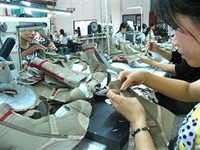|
|
| New prospects for exports to the Middle East |
4/25/2009 11:40:00 AM
Vietnam and several nations in the Middle East have recently signed trade agreements, paving the way for the two sides to increase bilateral cooperation. This is a good chance for Vietnamese businesses to penetrate a market of more than 250 million consumers. According to the Ministry of Industry and Trade (MoIT), two-way trade between Vietnam and the Middle East in 2007 reached US$1.2 billion, including US$700 million in exports from the Southeast Asian nation. The figure did not include a large volume of Vietnamese goods exported to the Middle East through third countries. Besides key markets such as the United States, Japan and the European Union, the Middle East is considered a new market for Vietnam, which has a comparatively high growth rate, averaging 30 percent per annum.
Vietnam mainly exports rice, coffee, garments, computers, electronics accessories, footwear, wooden products and seafood to the Middle East, while it imports petrol, petrochemical products, fertiliser and steel from the region.
Consumers in the Middle East, especially in the United Arab Emirates (UAE), have taken a liking to Vietnam’s frozen seafood. The Saigon Trade Corporation (satra) says together with Russia, the Middle East will be a key market for Vietnam’s frozen shrimp and fish fillets from now till 2010.
In addition, this market has a high demand for furniture, agricultural products and foodstuffs which are Vietnam’s key export staples. Dang Ngoc Quang, a former trade counsellor in Dubai (the UAE), says the export of these products to this market has increased sharply since Vietnam built a trade centre in Dubai. To boost exports, he suggests that Vietnamese businesses make use of different distribution channels.
The MoIT says that if Vietnam establishes good relations with the Middle East which spans southwestern Asia and northeastern Africa, it can penetrate other markets nearby. Recognising this potential, it has established and expanded business links to Iraq, Turkey, the UAE, Israel and Saudi Arabia.
Among them, the UAE and Saudi Arabia are Vietnam’s key target markets. With a population of 27.6 million, the UAE imports a great deal of pepper, rice, tea, garments and footwear which are Vietnam’s main export products. In addition, this market has an increasing demand for recruiting guest workers, including those from Vietnam.
According to the MoIT, the competitiveness of products in the Middle East remains strong as nations in that region enjoy high economic growth rates of between 6-14 percent per year and they have similar tax policies. This requires Vietnamese businesses to improve product quality and fulfil their commitments in export contracts regarding delivery time if they want to gain a firm foothold in this market. |
| VOV |
| |

